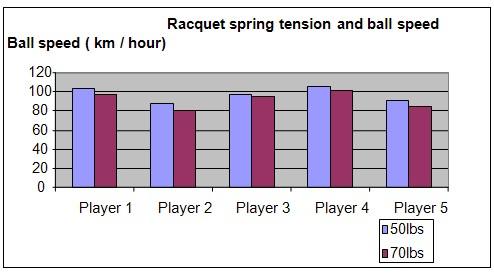| Complexity level: | 8 |
| Project cost ($): | 120 |
| Time required: | 1 hour to prepare, 6 hours for this science project experiment |
| Material availability: | You will need a radar gun. Their prices vary tremendously (some cost a few hundred dollars), but a fairly cheap and effective model is the Bushnell Speedster II - it should cost less than $100 |
| Safety concerns: | Basic safety requirements |
Hypothesis
The racquet with the lower tension level will make the ball travel faster.
Overview
Tennis racquet and ball speed
The speed that a tennis ball travels at after being hit by the racquet is determined by the power/strength of the player and the speed with which the racquet is swung. As different parts of the racquet will be traveling at different speeds during the swing, the location at which the ball hits the racquet also affects the resultant ball speed.
The power of the racquet is determined by its weight, the stiffness of its frame and the tension of the strings. The weight of the racquet is important in determining the potential power: the heavier the racquet, the higher its potential power. It is also most powerful at the balance point of the racquet, also called the “sweet spot” and normally located about 75mm above the neck of the racquet. Hitting the ball at other spots will cause the racquet to spin or recoil upon impact.
A racquet frame that lacks stiffness can cause the racquet to bend or twist upon contact with the ball. This will result in loss of power due to the bending action - if the racquet does not spring back in time, the ball would not have launched with maximum speed and power.
If the string tension of the racquet is too high, it will cause the shape of the ball to deform upon impact. In the centre of the string bed, the strings are longer and able to provide more cushioning, resulting in less ball deformation and less energy loss. If the tension of the strings is too high, or the ball is hit off-centre (where the strings are shorter), ball deformation will cause the tennis ball to lose up to half of its energy.
Scientific Terms
Materials
The materials required for this science fair project:
- 5 amateur tennis players
- 1 tennis court
- 2 tennis racquets, both with frames of the same weight and design.
- 1 box of tennis balls
- Radar gun to measure speed (may be purchased from radar gun suppliers such as Radar Sports)
Procedure
1. For this science fair project, the independent variable is the tension level of the string in the racquets – 50lbs or 70lbs. The dependent variable is the resultant velocity of the ball, determined using the radar gun. The constants (control variables) are the skill of the tennis player, the weight of the racquets, the stiffness of the racquet frames and the type of tennis balls used.
2. The strings on the 2 tennis racquets are adjusted so that the first racquet will have a string tension of 50 lbs while the second racquet will have a string tension of 70 lbs.
3. The tennis players are allocated a number 1 to 5 and asked to warm up before the experiment is started.
4. The 1st tennis player is asked to serve the ball using the racquet with 50 lbs string tension. The speed of the ball after the serve is measured using the radar gun. The ball is served 5 times by the same player and the maximum speed reached is recorded in the table below.
5. The first tennis player is next asked to serve the ball using the racquet with 70 lbs string tension. The serve is again performed 5 times and the speed is measured using the radar gun. The highest speed observed is recorded in the table below.
6. Steps 4 and 5 are repeated using the remaining 4 tennis players, and the maximum speed reached by the ball out of each of the 5 attempts by the same player using the same racquet is recorded in the table given below.

Results
The results show that all the 5 tennis players were able to hit and make the ball travel faster when using the racquet with the 50 lbs string tension.
| Racquet string tension | Highest speed of the ball measured using radar gun (km / hour) | ||||
| Player 1 | Player 2 | Player 3 | Player 4 | Player 5 | |
| 50lbs | 103 | 87 | 98 | 106 | 91 |
| 70lbs | 98 | 81 | 94 | 102 | 85 |
The graph below represents the results of our science experiment.

Conclusion
The hypothesis that the racquet with the lower string tension will make the ball travel faster, is proven to be true.
The speed of the ball is determined by the combination of racquet speed and power. When the ball is hit near the neck of the racquet, more power is gained but te speed is lost. Hitting the ball near the tip of the racquet will provide greater speed but it will lack in power. It is therefore up to the player to find the best spot at which to hit the ball, such that it complements the player's strength, speed and skill.
Also consider
This science fair project can also be conducted using racquets of different weights.
Perhaps you could also measure the distance traveled by the ball?
References
Why is maximum power in the throat and the maximum shot speed toward the tip? - http://twu.tennis-warehouse.com/learning_center/PPandspeed.php
Power: Does the racquet matter? - http://twu.tennis-warehouse.com/learning_center/racquetcontribution.php

